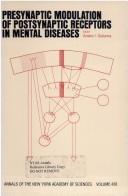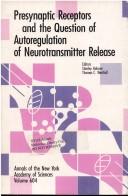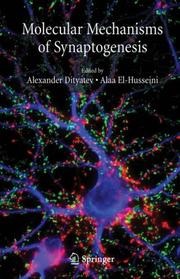| Listing 1 - 4 of 4 |
Sort by
|

ISBN: 0897662555 9780897662550 Year: 1984 Volume: 430 Publisher: New York, N.Y. New York Academy of Sciences
Abstract | Keywords | Export | Availability | Bookmark
 Loading...
Loading...Choose an application
- Reference Manager
- EndNote
- RefWorks (Direct export to RefWorks)
Neuropathology --- Synapses --- Neurotransmitter receptors --- Mental illness --- Presynaptic receptors --- Congresses --- Synapses - Congresses --- Neurotransmitter receptors - Congresses --- Mental illness - Congresses

ISBN: 0897666135 0897666143 Year: 1990 Volume: 604 Publisher: New York, NY : New York Academy of Sciences,
Abstract | Keywords | Export | Availability | Bookmark
 Loading...
Loading...Choose an application
- Reference Manager
- EndNote
- RefWorks (Direct export to RefWorks)
Autoreceptors --- Presynaptic receptors --- NEUROREGULATORS --- SYNAPTIC RECEPTORS --- Congresses. --- Neuroregulators --- Synaptic receptors --- Congresses --- RECEPTORS, ENDOGENOUS SUBSTANCES --- PHARMACOLOGY --- CONGRESSES --- PHYSIOLOGY

ISBN: 1280716282 9786610716289 038732562X 0387325603 Year: 2006 Publisher: New York, NY : Springer,
Abstract | Keywords | Export | Availability | Bookmark
 Loading...
Loading...Choose an application
- Reference Manager
- EndNote
- RefWorks (Direct export to RefWorks)
Molecular Mechanisms of Synaptogenesis is a compilation of recent exciting findings that summarizes the ever-expanding knowledge of how neuronal contacts develop in the normal brain and how their functions are affected in mental disorders. In the last decade, advances in molecular and cellular biology, combined with the development of sophisticated fluorescence microscopy tools to visualize synapses in live neurons, have revealed many intriguing and unexpected findings regarding the dynamics of synapse formation. Studies by a number of researchers have identified several critical protein components of synapses and shown the time course of their arrival at the synapse. Several molecules serve to hold the synaptic contacts between nerve cells and regulate their function. Imbalance in synaptic contact formation and function has been linked to psychiatric disorders such as schizophrenia, autism and mental retardation. The recent advances in basic research, summarized in Molecular Mechanisms of Synaptogenesis, may lay the necessary scientific groundwork to develop treatments targeting synaptogenesis, allowing us to improve the lives of people affected by brain disorders. This book will be an invaluable resource for neurobiologists taking their first steps in the expanding and exciting field of synaptogenesis.
Neural transmission. --- Synapses. --- Neurotransmitters. --- Cytoskeletal proteins. --- Presynaptic receptors. --- Neurotransmitter receptors --- Structural proteins --- Proteins --- Chemical nerve transmitters --- Nerve transmitter substances --- Neural transmitters --- Neurohumors --- Neuroregulators --- Synaptic transmitters --- Transmitters, Chemical nerve --- Transmitters, Synaptic --- Neurochemistry --- Neural transmission --- Nerve endings --- Nerves --- Neural circuitry --- Synaptosomes --- Nerve transmission --- Nervous transmission --- Neurotransmission --- Synaptic transmission --- Transmission of nerve impulses --- Neurophysiology --- Neurotransmitters --- Neurosciences. --- Neural sciences --- Neurological sciences --- Neuroscience --- Medical sciences --- Nervous system
Book
ISBN: 9401781095 9400763336 9400763344 Year: 2013 Publisher: New York : Springer,
Abstract | Keywords | Export | Availability | Bookmark
 Loading...
Loading...Choose an application
- Reference Manager
- EndNote
- RefWorks (Direct export to RefWorks)
This book brings together leading international experts to discuss recent advances in the regulation of presynaptic voltage-gated Ca2+ channels (VGCCs), key signal transducers that represent one of the most widely modulated proteins in the body. It is now commonly accepted that presence of the VGCC complex defines an excitable cell. At a basic level, VGCCs transduce membrane potential change to chemical neurotransmitter release at presynaptic terminals. However, on-going scientific research, presented here, in areas including neuroscience, electrophysiology, pharmacology, biochemistry and, increasingly, proteomics, has revealed the widespread nature of modulation of the presynaptic VGCC complex. This book reviews and discusses the following topics: The fundamental role of the VGCC pore-forming CaVa subunit, and some of their binding partners, in presynaptic function and synaptic plasticity. Modulation of presynaptic CaVa subunits by auxiliary CaVb and a2d subunits and by their major interaction partners, such as active zone scaffolding proteins, synaptic proteins, G proteins and small GTPases, which, together, contribute to the VGCC proteome. Work at the cutting edge of research, including how direct electrophysiology recordings from presynaptic terminals and introduction of synthetic CaVa peptides into presynaptic terminals has expanded our knowledge of VGCC function. Evidence emerging over the last decade demonstrating that VGCC subunits represent bona fide molecular targets for therapeutic drug discovery. This development is illustrated by the introduction of the CaV2.2 blocker ziconotide, which represents an important proof-of-concept, but is best exemplified by the emergence of gabapentinoids, which bind the VGCC auxiliary a2d subunit, as first-line treatments for chronic neuropathic pain. Throughout, chapters are accompanied with illustrative Tables and Figure providing a useful and comprehensive summary of the current state-of-play in this area of significant therapeutic interest. Work described here also provides a solid basis for future research in this important area.
Calcium -- Physiological effect. --- Calcium channels. --- Calcium. --- Presynaptic receptors. --- Ion Channels --- Electrophysiological Processes --- Nervous System Physiological Processes --- Intercellular Junctions --- Axons --- Signal Transduction --- Nervous System --- Physiological Processes --- Membrane Glycoproteins --- Biochemical Processes --- Membrane Transport Proteins --- Nervous System Physiological Phenomena --- Cell Physiological Processes --- Electrophysiological Phenomena --- Neurons --- Nerve Fibers --- Cell Membrane Structures --- Anatomy --- Cell Membrane --- Biochemical Phenomena --- Membrane Proteins --- Physiological Phenomena --- Carrier Proteins --- Cells --- Musculoskeletal and Neural Physiological Phenomena --- Chemical Processes --- Cell Physiological Phenomena --- Proteins --- Chemical Phenomena --- Phenomena and Processes --- Cellular Structures --- Amino Acids, Peptides, and Proteins --- Chemicals and Drugs --- Neuronal Plasticity --- Synaptic Transmission --- Synapses --- Presynaptic Terminals --- Calcium Channels --- Calcium in the body. --- Channels, Calcium --- Medicine. --- Cell physiology. --- Cell membranes. --- Neurobiology. --- Biomedicine. --- Biomedicine general. --- Membrane Biology. --- Cell Physiology. --- Body composition --- Calcification --- Ion channels --- Cell function --- Cytology --- Physiology --- Cell surfaces --- Cytoplasmic membranes --- Plasma membranes --- Plasmalemma --- Membranes (Biology) --- Glycocalyces --- Neurosciences --- Clinical sciences --- Medical profession --- Human biology --- Life sciences --- Medical sciences --- Pathology --- Physicians --- Biomedicine, general. --- Health Workforce --- Cell membranes .
| Listing 1 - 4 of 4 |
Sort by
|

 Search
Search Feedback
Feedback About UniCat
About UniCat  Help
Help News
News